"Добірка цікавих завдань для вивчення рідного краю та виховання громадськості та патріотизму на уроках англійської мови"
Ця добірка цікавих завдань для вивчення рідного краю та виховання громадськості та патріотизму на уроках англійської мови містить завдання, які можна використати на уроках у 5-11 класах, протягом вивчення англомовних країн і у порівнянні з своїм регіоном, країною.
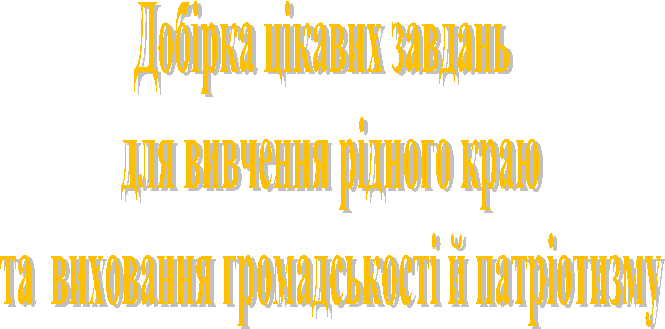 Everything starts from our native home, native symbols and protective signs.
Everything starts from our native home, native symbols and protective signs.
Storks and poplars, snowball trees and periwinkles, wells and windmills, mallows and marigolds are the part of Ukrainian life.
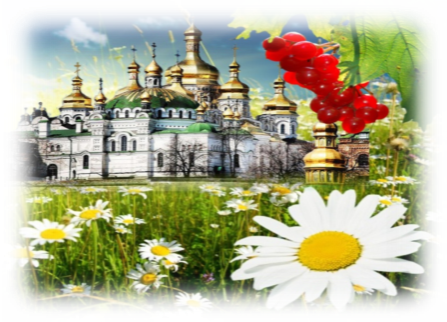
FORM 5. Reading
Read the text. OLD KYIV
Our capital is a very old city. It had two main parts: the “Upper Town” and the “Lower Town” (Podol).
There were big walls around the Upper Town. There were four gates in the walls. Now you can see only the Golden Gates. In the centre of Upper Kyiv there was Sophia Cathedral. Rich people lived in the Upper Town.
The working people lived in Podol. Cows, goats and other domestic animals lived with them in Podol too. The working people built nice houses and churches in Old Kyiv. They could make many things. They were good craftsmen. The men defended Kyiv against enemies.
Mark the statements true (T) or false (F)
1. Our capital is a very young city.
2. There were not any walls around the Upper Town.
3. There were four gates in the walls.
4. Rich people lived in the Upper Town.
5. The working people lived in Podol.
6. There were no domestic animals in Podol.
7. The men couldn't defend Kyiv against enemies.
'Upper Town — центр міста craftsmen - ремісники
'Lower Town — околиця defend – захищати
LISTENING
Listen to the text Khreschatyk Street
Kyiv is the capital of our country. It is the largest city in Ukraine.
We are proud that our capital is one of the best and oldest cities in the world.
Khreschatyk is the main street in Kyiv. It is not very long, but it is wide and straight. You can see many cars and trolley buses in Khreschatyk. There are many big green trees in it. A lot of people go to Khreschatyk every day. Some of them go shopping because there are many good shops and big market there. Other people go to the cinema, look at the fountains or sit on the benches.
In the evening many people walk in Khreschatyk. There you can see many bright lights.
People like the main street of Kyiv because it is nice and green.
Test 1. Listen to the text "KHRESCHATYK". Choose the right word to each sentence.
1. Khreschatyk is the …street in Kyiv.
A. longest B. main
2. There are many …trees in it.
A. chestnut B. green
3. … people go to Khreschatyk every day.
A. a lot of B. a few
4. In the evening some of the people…in Khreschatyk.
A. walk B. ride
5. There you can see many … .
A. salutes B. bright lights
6. People …the main street of Kyiv.
A. don't like B. like
7. People are proud of its … .
A. capital B. native town
Test 2. Listen to the text “WHO WERE THE KOZAKS?”
- Pre – listening
(new words: tsars, masters, freedom, empress, break up – broke)
Match to make up word-combinations.
1. national A. people
2. talented B. country
3. to win C. emblem
4. independent D. region
5. Zaporizhya E. victory
6. fight for F. freedom
2. Listen to the text “Who were kozaks?”
The word kozak means a free and independent man.
First Kozaks lived in Ukraine many hundreds years ago. But the most famous are Zaporizhian Kozaks. They were very brave and strong. They didn’t like tsars. They didn’t want to work for masters. They loved freedom. They made their own state — Zaporizhian Sich. They called their leader ‘koshovyi otaman’. The bravest one was Ivan Sirko. He won many victories.
The main idea of Zaporizhian Sich was to fight for independence of their native land. Scientists say that Zaporizhian Sich was a good example of a democratic state. Zaporizhian Kozaks were really free and independent people.
Russian Empress broke up Zaporizhian Sich.
Legends and songs brought us the names of these national heroes: Bohdan Khmelnytskyi, Petro Doroshenko, Ivan Mazepa, Petro Sahaidachnyi. Their names will live in hearts and minds of true Ukrainians forever.
Match the parts to make up sentences “Who were Kozaks?”
1. The word "kozak" means…
2. First Kozaks lived…
3. They were very…
4. They called their leader…
5. Zaporizhian Sich was…
6. Legends and songs brought us…
7. The bravest one was…
8. Their names will live in…
A. brave and strong.
B. "koshovyi otaman".
C. the names of these heroes.
D. Ivan Sirko.
E. our hearts and minds.
F. in Ukraine.
G. a free and independent man.
H. a good example of a democratic state.
3. Read the text again and choose a) or b) and complete the sentences.
1) Kozaks were...
a)not independent people
b)free people
2) The main idea of Zaporizhian Kozaks was ...
a)to be independent
b)to work for their masters
3) Kozaks called their leader...
a)tsar
b)koshovyi otaman
4) Ivan Sirko
a) broke up Zaporizhian Sich.
b) won many victories
5)Kozaks fought for...
a) independence of their native land
b)Russian Empress
6)Kozaks were men who loved ...
a)freedom and independence.
b)their masters.
Writing
- Write a composition on the topic "My native city in Ukraine". Fill in the chart. Then write sentences.
Words to use:
the name; the region; well-known people; places of interest; history/dates; legends/ heroes; symbol/emblem
It is in …… region.
It stands on the …… river.
(It) is …… years old.
(How many) …… people live here.
… was famous for ……
Well-known people …… lived and visited it.
There are many …… in it.
There is (no) legend about the city …….. .
Its symbol is …… .
You are welcome! (I am sure you'll love it).
- Spell Ukrainian cities in English. Use the table
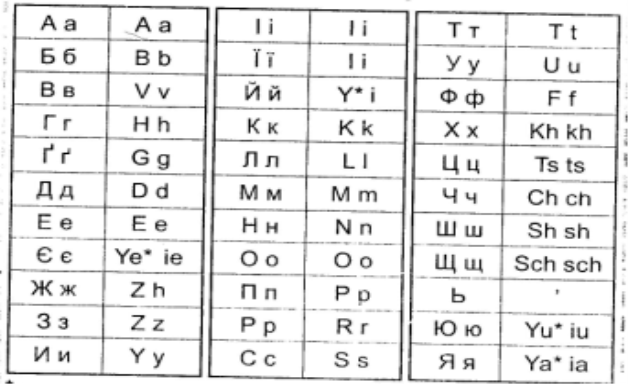
1. Тернопіль
2. Луцьк
3. Миколаїв
4. Одеса
5. Харків
6. Київ
7. Житомир
8. Рівне
9. Запоріжжя
10. Полтава
11. Черкаси
12. Івано-Франківськ
13. Херсон
14. Чернівці
TULCHYN
THE PLACE
WE LIVE IN
Do these tasks to learn about Tulchyn! This is the city of Suvorov, Leontovych, Pushkin, the chief center of the Southern Society of the Decembrists and the city of the Polish magnates Count Pototskys.
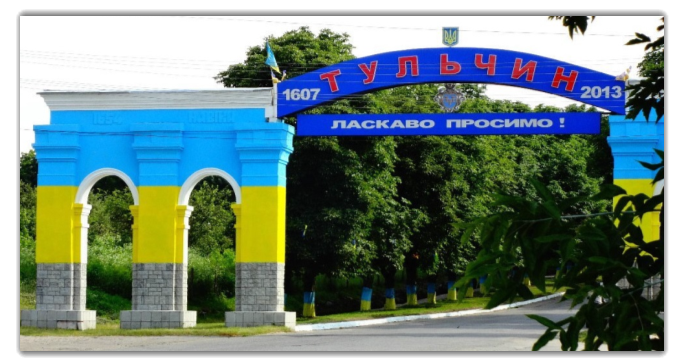
FORM 6 – 7
READING - LISTENING
Places of interest in Tulchyn
My native town Tulchyn is a very old town with interesting history. It was founded 400 years ago and there are many places connected with the history of Ukraine. You can see many old and beautiful buildings and monuments to famous people who lived and worked in Tulchyn.
Tulchyn is one of the most interesting historical cities in Ukraine. This is the city of Suvorov, Leontovych, Pushkin, the chief center of the Southern Society of the Decembrists, where Pavel Pestel was located during planning of the rebellion. The city has many historical and architectural monuments, especially famous Pototsky Palace, one of the first buildings of the Polish classicism in Ukraine.
In Gagarin Street the history of the city can be found in the Local History Museum, where weapons, military equipment and clothing of the 18 – 19th centuries are exhibited and art exhibitions are constantly held. There are many exhibits telling us about the famous people, culture, economy and natural conditions of Tulchyn in it.
You can also learn the history of the town in the museum - apartment of Nikolai Dmitrievich Leontovych.
When you first come to our town you will see the monument to Oleksandr Suvorov in the centre of the town. I think this monument is the symbol of Tulchyn, because 200 years ago the outstanding Russian Field-Marshal lived in our town and trained Russian soldiers to fight against Napoleon's army. In Tulchyn he also wrote his famous book “The Science To Win”.
Behind the monument you will see a very beautiful building, the Dominican Cathedral, built in the 17th century. Another architectural monument is Pototsky’s Palace. Due to advantageous location and friendly view, Count Pototsky Palace complex, built by the thousand skilled and talented builders of Tulchyn, brings glory and fame to the town. It makes great impression on visitors. Since 1984 the palace housed Tulchyn College of Culture. Every year more than 380 people study there. Pototsky Palace is an architectural monument of the 18th century.
In front of the Palace of Culture you will see the monument to M. Leontovych, the famous Ukrainian composer and musician who is known and loved for his musical works. The city became the home to Ukrainian composer who produced several of this choral masterpieces (including world famous "Carol of the bells") when he lived here.
The great Russian poet Oleksandr Pushkin visited Tulchyn several times and wrote about it in his poem “Yevheniy Onegin”. The monument to Pushkin is in the centre opposite the post office.
People who lived in Tulchyn many years ago wanted to build a beautiful city, where people of different nationalities would live in peace.
I am proud of my native town and want it to be always beautiful.
- Read (listen to) the text and find the names of the famous people who lived or visited the town.
- Read the text and say if the sentences are TRUE or FALSE
- The town is very old and there are many old and beautiful buildings and monuments in Tulchyn.
- Leontovych and Pavlo Pestel were born and worked in Tulchyn.
- In the centre of the town we can find the monument to Oleksandr Suvorov.
- The outstanding Prussian Field-Marshal lived in our town and trained soldiers to fight against enemies.
- The Dominican Cathedral is a very beautiful new church.
- Pototsky Palace brings glory and fame to the town because of good position.
- Since the 21st century there is Tulchyn College of Culture in the palace.
- The famous Ukrainian composer created "Carol of the bells" when he lived in Tulchyn.
- The great Russian poet wrote about Tulchyn in his poem “Yevheniy Onegin”.
- This beautiful city was built by famous people.
- Speak about your native town and add some information about the place in the town you like to visit most of all.
- Write a composition on the topic “What should we do to make our town better?” or an advertising city guide, using the information in the text “Tulchyn”.
FORM 5 – 9
TOPIC:
“MY NATIVE
REGION”
SEVEN WONDERS OF VINNYCHYNA
Vinnychyna is a region full of interesting historical sights that we may also call its own wonders.
Get to know seven of them:
- Brailiv town
- Busha village
- Shargorod town
- Nikolai Pirogov’s house
- Nemyriv Gorodyshche
- Liadova village
- Picturesque Tulchyn town
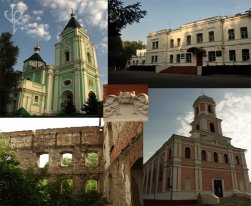 Brailiv town is situated in Zhmerinka region. Brailiv is one of the oldest historical villages in Podillya. It borrowed its name from the names of the rivers Brala and Reeve, and the ancient town called Brahiriv.
Brailiv town is situated in Zhmerinka region. Brailiv is one of the oldest historical villages in Podillya. It borrowed its name from the names of the rivers Brala and Reeve, and the ancient town called Brahiriv.
The first settlement on this particular spot belonged to Tripillan civilization.
Catholic church with Trinitarian Monastery is a historical sight of Brailiv. The complex was built in 1740 by Franciszek and Stanislaw Pototsky. Later the Monastery was transformed into Orthodox Holly Trinity Monastery. The Monastery is located on the upland and can be easily viewed from any part of Brailiv. In the monastery there were 3 churches: Trinity, St. Anthony and Theodosius Pecherskys’, St. Nicholas’.
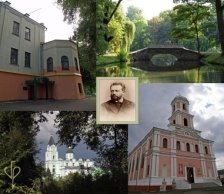 The brilliant composer Piotr Tchaikovsky, who wrote several splendid pieces during his stays at the house of Nadezhda Von Meck in Brailiv, dedicated to Brailiv his "Recollection of Dear Place" for piano and violin. Tchaikovsky and Nadezhda Von Meck Museum was opened in former Von Meck Palace.
The brilliant composer Piotr Tchaikovsky, who wrote several splendid pieces during his stays at the house of Nadezhda Von Meck in Brailiv, dedicated to Brailiv his "Recollection of Dear Place" for piano and violin. Tchaikovsky and Nadezhda Von Meck Museum was opened in former Von Meck Palace.
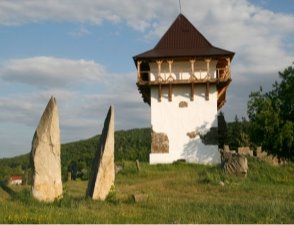
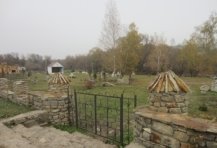
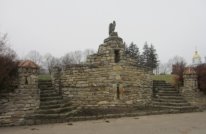 Yampil region can boast not only of generous sunny valleys and fertile lands, but of impressive cultural heritage and spiritual wealth.
Yampil region can boast not only of generous sunny valleys and fertile lands, but of impressive cultural heritage and spiritual wealth.
Busha village is a National Reserve in Yampil region. Hidden in a deep valley between the Murafa and Bushanka rivers, the village is attractive, first of all, due to the beautiful surrounding scenery with green mountains, swift rivers and spacious fields.
 Busha is one of the oldest settlements in Podillya, has a unique set of six archeological, historical and cultural relics exhibited in the area of 16 ha. The old village cemetery in Busha makes part of the State Historical and Cultural Heritage Reserve.
Busha is one of the oldest settlements in Podillya, has a unique set of six archeological, historical and cultural relics exhibited in the area of 16 ha. The old village cemetery in Busha makes part of the State Historical and Cultural Heritage Reserve.
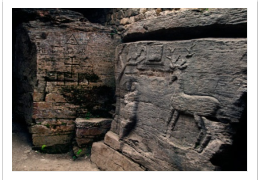 Busha entered the history of Ukraine due to the liberation war of 1648-1654, which took place under the leadership of Bohdan Khmelnitsky. At that time it was a big city in Bratslavshchyna with castles, underground passages and towers. The remaining buildings and underground passages during the liberation war were destroyed. Anyone who happens to visit Haidamatsky Yar for the first time freezes in astonishment. The scenery of this place on the bank of the Bushanka river is very impressive. There are the first people pictures there.
Busha entered the history of Ukraine due to the liberation war of 1648-1654, which took place under the leadership of Bohdan Khmelnitsky. At that time it was a big city in Bratslavshchyna with castles, underground passages and towers. The remaining buildings and underground passages during the liberation war were destroyed. Anyone who happens to visit Haidamatsky Yar for the first time freezes in astonishment. The scenery of this place on the bank of the Bushanka river is very impressive. There are the first people pictures there.
Shargorod Region as a part of Podillya historic region, has passed complicated historic pathway. Many nations have owned this Land for centuries. Shargorod is the unique place of Eastern Europe where so many different cultures have coexisted for many centuries on its tiny territory.
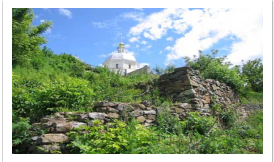 The town of Shargorod started its active development when the territory became the property of well-known Polish Noble Sir Yan Zamoisky.
The town of Shargorod started its active development when the territory became the property of well-known Polish Noble Sir Yan Zamoisky.
There are three architectural monuments of national significance in Shargorod: Roman Catholic Church of Saint Florian, Orthodox Monastery of Saint Nicolas, the Synagogue and six monuments of local significance including the family palace of Sir Zamoisky, the originator of the town.
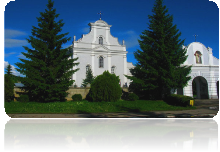
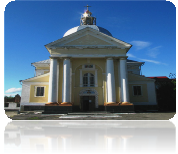

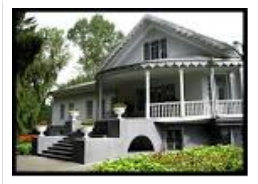 The last 20 years of Nikolai Pirogov's life were associated with Vinnytsia. Great scholar, the founder of the field surgery, father of the Russian Red Cross, doctor who saved life of the Italian patriot Giuseppe Garibaldi, all these definitions refer to Nikolai Pirogov. His estate near Vinnytsia was transformed into a museum with a small church and necropolis on its territory.
The last 20 years of Nikolai Pirogov's life were associated with Vinnytsia. Great scholar, the founder of the field surgery, father of the Russian Red Cross, doctor who saved life of the Italian patriot Giuseppe Garibaldi, all these definitions refer to Nikolai Pirogov. His estate near Vinnytsia was transformed into a museum with a small church and necropolis on its territory.
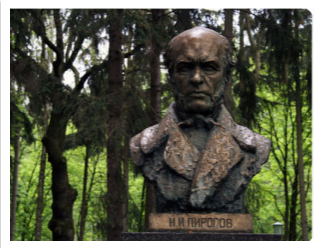
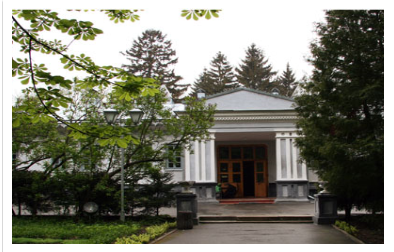
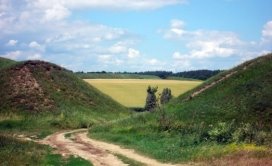 Nemyriv Gorodyshche, located not far from Nemyriv city, represents remains of the ancient Scythian settlement and dates back to the 7th – 6th centuries B.C.
Nemyriv Gorodyshche, located not far from Nemyriv city, represents remains of the ancient Scythian settlement and dates back to the 7th – 6th centuries B.C.
 The Scythian settlements or Nemyriv banks occupy field area of 150 ha, surrounded by the earth hill.
The Scythian settlements or Nemyriv banks occupy field area of 150 ha, surrounded by the earth hill.
Nemiriv Scythian settlement was the biggest and the richest one among the similar findings discovered on the whole territory of the former Soviet Union. The remains of the Trypillyan settlement have been found on the same spot.
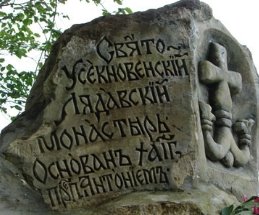
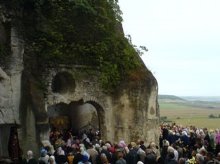 Saint Beheading Orthodox Pechersky (Cave) Monastery was founded in the 11th century by Saint Antony. There is a legend that when Saint Antony Pechersky was returning from the Holly Mount Athos he liked the beauty of nature and that deserted place near Liadova village.
Saint Beheading Orthodox Pechersky (Cave) Monastery was founded in the 11th century by Saint Antony. There is a legend that when Saint Antony Pechersky was returning from the Holly Mount Athos he liked the beauty of nature and that deserted place near Liadova village.
St Anthony settled in one of the caves. Later he founded the cave temple and also the Monastery, where St. Anthony educated and taught many monk brothers.
Located on the southern edge of the village on the hundred meter height of the steep chalky rocks, the Monastery is active today under the name of Saint Beheading Orthodox Pechersky Monastery.
A lot of pilgrims and visitors come to the Monastery every day. It’s the oldest architectural monument of the 11-19th century, an outpost of Orthodoxy in the southwest of our country.
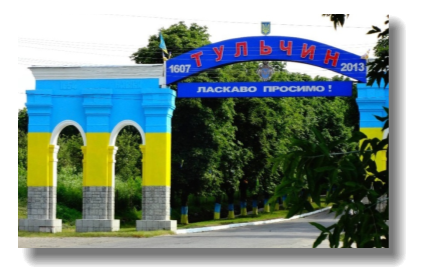 Picturesque Tulchyn region is the land of our courageous ancestors, the breathing history land and preserving its own customs and traditions.
Picturesque Tulchyn region is the land of our courageous ancestors, the breathing history land and preserving its own customs and traditions.
The region is known for its 15 natural preserves and wildlife areas with total surface exceeding one thousand hectares.
In 1726 Tulchyn became a residence of the Polish Magnate Stanislaw Pototsky and in 1775 was inherited by his nephew son Stanislaw Felix Pototsky. He transformed a small town to quite a developed city.

The visitors coming to Tulchyn for the first time see numerous cultural, historical and architectural attractions and relics that add a unique touch to the city image. The Majestic Palace ensemble of the Pototsky family, built in 1782 in classical style and turned its face to the town, remains the most valuable part of the cultural and architectural heritage possessed by Tulchyn.
The palace consists of a main two-storey building with the entrance decorated by 10 columns with 8 pilasters and then the two side buildings in the same style. Its roof was covered with copper. The glass galleries connect the main building with the two side buildings. Pototsky Palace is an architectural monument of the 18th century.
Додатoк 3. Additional texts for reading and listening
Kyiv
The capital of Ukraine is Kyiv. It is one of the most beautiful cities in the world. It is situated on the picturesque banks of the Dnipro River. More than three million people live there.
The streets of Kyiv are wide and nice. They are lined up with chestnut trees, lime trees and poplars. A chestnut is a symbol of Kyiv.
Kyiv is the political, economic, scientific, industrial and cultural center of Ukraine. There are over 20 higher educational establishments in Kyiv. There are many museums, art galleries, concert halls, theatres and cinemas in it. They are very popular with tourists. Kyiv is also famous for its attractive parks.
The city has a well-developed transport system. Many buses, minibuses, trolley-buses, trams and cars carry passengers around the city. There is also an underground, a railway station, an airport and a river port in it.
Kyiv has a long history and rich culture. That is why there are many places of interest there. It is one of the oldest cities in Europe. There are many ancient cathedrals and churches, museums and monuments, beautiful streets and squares in it.
The main street of Kyiv is Khreshchatyk. If you have never been to Kyiv you should start your sightseeing there. The street is only one kilometre long but is very impressive.
Kyiv is famous for its Kyivo-Pecherska Lavra. More than 80 buildings were built on its territory during 900 years of the monastery’s existence. For many people it is a saint land where they come to worship, to visit holy caves, to pray in the churches.
Tourists always go to have a look at the monument to Bohdan Khmelnytsky, the outstanding Ukrainian statesman and military leader.
The State Historical Museum of Ukraine is in Kyiv too. The exposition tells us about the history of Ukraine and its culture from ancient times to the present days.
The Golden Gates, St.Andrew’s Church, the monuments to Prince Volodymyr and Taras Shevchenko are the must of every tourist.
Kyiv Shevchenko Opera and Ballet House, Kyiv Ivan Franko Drama Theatre are well-known all over the country.
Any place is interesting in its own way and when we visit it we love this city and country more. Kyiv is growing, it also becomes more beautiful.
Customs and Traditions in Ukraine
One of the most peculiar features of life in Ukraine which strikes any visitor to this country is the cherishing and preserving of many traditions and customs, sometimes very archaic as they may seem.
The Ukrainian people have the tradition to meet guests with bread and salt on a special towel which is called “rushnik”. It is a symbol of hospitality of the Ukrainian people. Embroided towels mark the celebration of all important occasions: engagement, marriage, birth, death, Christmas and Easter. Special towels are often used to serve ritual breads and in many homes a “rushnyk” is draped around icons or family portraits. The towel on the wall is our ancient custom. To accept the towel, to kiss bread symbolize unity, peace, deep respect among the people. This custom has become a good tradition in our country.
The traditional embroidery is another distinctive element of Ukrainian culture, the inexhaustible source of popular creative work. It is widely spread in various variants as clothes ornament and decoration of clothes and interior. Each region of Ukraine has its own style of embroidery. Embroidered shirts called “sorochky” were traditionally worn by both men and women.
Bread and salt are used as a symbol of welcome. These two foods are an essential part of everyday life and ceremonial occasions.
There are many traditional meals in Ukraine such as the one served on Christmas Eve when no fewer than 12 dishes are prepared without using meat or dairy products.
Ukrainian parties “vechornytsy”are a custom to spend free time in the evening with songs and poems, stories, jokes and dances.
The decoration of “pysanka” is a rich folk art tradition dating back to prehistoric times in Ukraine. Eggs symbolize the rebirth of life.
Batic is the technique used to apply designs in various colours.
One of the popular traditions is the famous Sorochintsy Fair in a village in the Poltava region called Velyki Sorochintsi. Every year the village welcomes guests from neighbouring countries and even from distant places.
Here everyone is doing something: selling, buying, singing and dancing. Whole rows of workshops are set at the fair.
You can buy some world famous Reshetilov’s embroidery. The famous masters are demonstrating their art, making milk pots. No one can resist tasting the borshch or galushky. You can see Gogol’s heroes-and Nikolai Gogol himself. The bandures, the violins, the accordions ring out merrily. Kobzar players recite.
Customs and traditions play a very important role, their social mission is to render rich spiritual values to young people. They adopt moral principles and norms and show solidarity of generations.
Kateryna Bilokur - Tragedy and Success
A century has passed since the birth of a great Ukrainian artist Kateryna Bilokur. Kateryna Bilokur was born in a peasant family in 1900 in the village of Bohdanivka near Yahotyn. She did not have any education and had to study by herself. She mastered literacy, read a lot and her soul craved for something unattainable .
The great word ‘artist’ seemed to her so magic and beautiful. She said to herself that sooner or later she would become an artist. She kept repeating that life without art wasn’t possible for her.
She had been very gifted in painting since her childhood. It was possibly the God’s providence that directed her hands, taught to discern colours and group the colour range. She began painting portraits of her relatives and villagers. In her later works Kateryna would extol a flower - the beauty of the land.
Her paintings derived from the life-giving source of folk creativity based on songs, legends, tales and decorative arts. She admired the patterns on household utensils, Ukrainian clothes, towels, but her tender poetic soul was mostly charmed by flowers that blossomed around her house, in the gardens, meadows and fields. She called them ‘my children’ considering them human beings. Some pictures have her own captions: “Painted from nature by K. Bilokur”.
She also called the flowers ‘the eyes of the Earth, the soul of the Earth’. Through them she comprehended nature and deepened her knowledge about it. She glorified flowers and said: “I’ll paint and paint flowers because I like to work on them so that I can’t find words to express my feelings to them, my great love for them”.
Kateryna Bilokur first exhibited her paintings in Poltava and Kyiv in 1940-1941. She was warmly welcome by her colleagues - Ukrainian artists and her way to recognition started.
But the Great Patriotic War began and her eleven paintings were burnt in Poltava museum. She lived through hardships and difficulties of this war. The 1950s saw another raise in her artistic career. Her works were exhibited in Moscow and other cities. The public was charmed by her pictures “Peonies”, “Still life with bread”, “Breakfast”, “Flowers and walnuts” and others.
But a well-known painter Kateryna Bilokur had lived all her life in pain and poverty; she did not have any family or children. Though the grave illness tortured her, she had to look after her sick mother. Great fame came later, after her death. The time has come to pay tribute: her works are exhibited in museums in Ukraine and abroad; a picture gallery bearing her name was open in Yahotyn; a street was named after her in Kyiv; a lot of books devoted to her life and works are published in many languages; The Bilokur Prize Fund was founded for praising the most talented artists and painters.
Match the beginning and ending of the following phrases from the text:
charmed...
Bilokur had lived all her life...
|
feelings to them.
creativity based on songs, legends, tales and decorative arts.
family or children.
Earth’. |
Key: 1-c; 2-g; 3-e; 4-a; 5-h; 6-b; 7-d; 8-f.
Traditional Food
- What is Ukrainians attitude to bread? What breads do Ukrainians like to eat?
- What are the most commonly eaten dishes in Ukraine?
- What is borsch made of?
- How are the following foods important for Ukrainian cuisine: bread; cereal; dishes made of flour; cabbage; borsch; milk; meat; beverages; potatoes?
Ukrainian cuisine is rich and varied. Since ancient times bread has held a special primary position in the cuisine of Ukrainian people. Sour rye bread and white wheat bread are baked in Ukraine. For the common people bread has always been an object of reverence. It is used to bring divine blessings to the commencement of every farm task, the marriage ceremony, the birth of a child, the move to a new home and as a sign of hospitality.
Cooked cereal, wheat, barley, buckwheat, millet, oat or corn porridge are an ancient Ukrainian food.
The favourite dishes made of flour are dumplings and filled dumplings with various types of fillings: cheese, potato, cabbage, meat, buckwheat. Noodles made of egg dough are served with soup or with cheese.
The potato is most widely used vegetable in Ukrainian cooking. It is the necessary ingredient in all soups. Boiled or baked potatoes are served with meat, fish, cheese, cabbage, mushrooms and potato pancakes are usually served with sour cream.
Another important element in Ukrainian cooking is cabbage, particularly sauerkraut which is used to make cabbage soup (kapusniak) or is served with meat, pea puree or potatoes. Cabbage leaves are used in making cabbage rolls (holubtsi) which are filled with buckwheat, rice and meat.
In Ukraine soup or borshch must be served for dinner. Various soups made with meat, fish, vegetables or milk are popular but borshch remains the favourite one. It is made of vegetables among which beets and cabbage are predominant.
Meat is usually eaten on feast days, Sundays or at family celebrations. The most popular meat is pork and its products, such as ham, sausage, blood sausage, smoked bacon and salt pork.
Foods prepared of milk, dairy products have long been a part of Ukrainian cooking. Sour milk is a favourite drink throughout Ukraine; cottage cheese is eaten mixed with sour cream. Salty cheese of sheep’s milk (brynza) is made in Hutsul Region and Bukovyna.
Bread kvas, fruit or pickled cucumber juice, and birch sap are popular folk beverages in Ukraine. Tea is the most widely consumed hot beverage followed by coffee and cocoa. Alcoholic beverages such as vodka, wine, fruit liqueurs (nalyvka), alcohol with pepper and beer have been popular for many centuries.
Deruny - A True Potato Classic!
Deruny is a traditional Ukrainian dish made of potato which can best be described as small potato pancakes fried in oil and served with sour cream. Those on a diet would undoubtedly wince should they ever attempt to count the amount of calories in this dish but nevertheless if you’ve never tried this local specialty, you will not truly appreciate just what the potato means to Ukraine! What is more deruny served without sour cream has always been one of the main Lenten dishes, being nutritious, tasty and of course without any of the ingredients which are prohibited by the Orthodox Church during this period. The Belarus dish ‘draniki’ is similar to deruny and just as well-known, with Belarussians claiming that it was they who first created the dish as the potato, or ‘bulba’, has always been a symbol of the fertility of their land, arguing that it was this vegetable which helped Belarus become an agricultural country in the first place. Some local scientists even believe that the potato has always been grown in Belarus though this idea seems to be based on patriotism rather than thorough historical research. In fact the potato only came to these lands during the reign of Peter the Great at the end of 17th century. Peter came across the potato while he was on his legendary grand tour of Europe and sent a whole sack to his friend Duke Sheremetyev, ordering him to distribute the vegetable to different regions of the Russian empire where it was to be a staple of the peasant’s diet. The question whether deruny is a Ukrainian or Belarussian creation continues being a mystery but regardless the way to make it remains the same: first you grate a potato and make it into a liquid pulp. To this you add some starch and eggs and then fry the mixture in the pan, thus creating small pancake fritters. The words ‘deruny’ and ‘draniki’ are probably derivatives from the word ‘drat’ which means ‘to whip or flog’, the punishment which was often handed out to village peasants in Ukraine and Belarus by wealthy landowners. Probably the treatment of the potato reminded the peasants of this painful punishment and may be the reason how the dish came to be known as ‘deruny’ and ‘draniki’. Lithuanian and Jewish cuisines also have similar dishes, the Lithuanian delicacy being called ‘cepelini’ and the Jewish treat ‘latkes’. Deruny can be cooked and filled in different ways though the basic recipe, including sour cream, remains the same. Deruny stuffed with meat or curd or served with fried mushrooms are particularly good. Belorussian cooks usually put the prepared draniki into an earthenware pot and top it up with either butter, fried onion or fried mushrooms. The effect of this is enhanced if the pot is then placed into a hot stove for a couple of minutes. This keeps the draniki or deruny hot for a long time as well as creating a ‘melt in your mouth’ texture. Enjoy the meal!
Додатoк 4. Holidays in Ukraine Form 5-6
Each country has its own customs, traditions and holidays. If to speak about Ukraine, we should tell about the most favourite holiday- New Year Holiday. People decorate the New Year tree and prepare presents for their relatives.
On the eve of January the 7th Ukrainians start celebrating Christmas. It’s the day of Jesus Christ’s birthday. People sing carols, cook a national Christmas dish named “kutіa”. Then people go to church.
Not long ago Ukrainians started celebrating St. Valentine’s Day. It’s the day of lovers when we give speсial cards and presents to our sweethearts. These are usually flowers and chocolates.
March the 8th is Women’s Day.
Easter Day comes according to the lunar calendar. It’s the Day of Jesus Christ’s Resurrection. People celebrate this Holiday because He died on the cross for our sake.
On May,1-2 Ukrainians celebrate the holiday of spring and beauty. All Ukrainians like these holidays because they can meet their close people and give them рresents.
On the ninth of May we celebrate Victory Day.
My favourite holiday is New Year’s Day. People get ready for this holiday long before it. They buy New Year trees and decorate them. Every year a fairy-tale comes to every house and every family on New Year's Eve. People believe that all their troubles are left in the previous year and the New Year will bring them hope and happiness and all their wishes and desires come true. It is a really wonderful holiday.
Ukrainian Holidays Form 7
Very often we look forward to holidays to enjoy ourselves. As you know, the word “holiday” comes from the words “holy day”. The matter is that holidays were at first religious festivals, but nowadays many of them have nothing to do with religion, It would be right to say that for the great part of the population they have lost their religious significance and are simply days on which people relax, eat, drink, make merry and don’t go to work .
Each country has holidays honouring important events in its history. As we live in Ukraine, we have our own customs and traditions, holidays and festivals. Some holidays are celebrated only in our country, others are celebrated in other countries too. Some holidays come on the same date of the same month, for instance, New Year’s Day or Christmas. Some, such as Easter are movable holidays.
We have New Year’s Day on January 1. It is one of the best holidays, because it has many fine traditions and it is the holiday of expectations. Before New Year’s Day we send postcards with New Year wishes to our friends. On the eve of the holiday people buy New Year trees, decorate them with coloured candles, balls and lights, put toy - Father Frost under the tree. In the morning children get presents from “Father Frost” and congratulate fathers and mothers with the happy New Year. The most common way of celebrating is the New Year party either a family party or one arranged by a group of friends. The celebration usually begins at 9 o’clock and goes on till the early hours of the morning. There are a lot of eating and drinking on the festive table. When the clock strikes 12, everybody drinks champagne and congratulates each other: “Happy New Year!”
Christmas Day is celebrated on the 25 of December by Catholics and on the 7th of January by the Orthodox Church every year. This holiday is of religious origin. Many people observe the tradition of going to church and having a tasty dinner. In early days people in our country played jokes and got presents for their performances “koliadki” and “schedrivki”.
Christmas is the most beloved festival among Ukrainians when the family gathers for a holy supper of 12 symbolic dishes. Food is one of the aspects of culture that endures the longest. If you lose the language you lose the literature and the songs, but you don’t have to speak Ukrainian to eat holubtsi (cabbage rolls) or pyrohy (pies).
The beginning of the holy supper is signaled by the first star. Christmas Eve is really a family celebration. Traditionally, the father brings in the “snip”, a handpicked wheat sheaf that represents the spirits of ancestors. The father sets it in a place of honour in the dining room before the table is set. Wheat, flour and bread are important to Ukrainians: they came from the land and Ukrainians are close to the land. Preparations start a week before Christmas, pounding and cleaning the choicest wheat to make “Kutia”. It is a dish of honey, poppy seeds and wheat kernels boiled in pure rainwater. Christmas Eve supper begins with the lighting of the beeswax candle in the braided bread centerpiece. After a carol and the Lord’s Prayer, the kutia is passed and everyone takes a spoonful. But nobody eats yet. The head of the family raises his spoonful and greets the family with “Khrystos Rozhdaietsia” (Christ is born). The family answers: “Slavymo yoho!” (Glory, praise him!). That’s the signal to start the meal. The meal is traditionally meatless and milk-free and features fish. The menus vary depending on what region of Ukraine your family comes from. The best - known dishes are “holubtsi” and varenyky or pyrohy (plump crescent-shaped dumplings). Broad beans, dried wild mushrooms, sauerkraut and beets figure in the side dishes. For dessert, compote of dried fruit and honey cake complete the menu. Carols usually end the evening and signal the start of a joyous season of visiting. Just why is Christmas so important in keeping this strong link with the past? Reaching back to our roots, knowing where we come from, helps us know where to go.
On the 8 of March we celebrate Women’s Day. It is a beautiful spring holiday when men give presents and flowers to their wives, mothers, sweethearts, girlfriends, sisters and daughters. Children congratulate their mothers on this holiday and prepare them a holiday card with the best wishes. This holiday is an occasion to express our love, tenderness and gratitude to those who care for us most - mothers, grandmothers, sisters and daughters.
The Shevchenko Days are traditionally celebrated in March every year.
Easter is a great national holiday. Easter is the main Christian feast, when the resurrection of Christ is celebrated, on the first Sunday after the first full Moon that coincides with, or comes after, the spring equinox on March 21. Easter begins with the Easter matins and high mass, during which the pasky (traditional Easter breads), pysanky and krashanky (decorated or coloured Easter eggs) are blessed in the church. After the matins all the believers sing the religious songs and exchange Easter greetings, give each other krashanky (symbol of life) and then hurry home with their baskets of blessed food. If they meet other people on the way they say: ’Christ has risen!’ and these people should reply ’Risen indeed’. Easter is a holiday of victory of life over death, good over evil.
In Ukraine we like Easter celebration very much, because it is a holiday of spring and revival.
The 1st of May as well as the 7th of November has lost its political meaning and now it is a traditional day-off.
But the 9th of May or the Victory Day will remain forever as the day of commemoration of those who perished in the war against fascism. We put flowers to the war memorials, to the tombs of the people who gave their lives for the freedom of the country. War veterans are greeted and there is salute and fireworks in the evening
On the 24 of August we celebrate the Independence Day. It is a birthday of an independent Ukrainian state. There are a lot of concerts and dances in the streets of the cities and towns.
 Visiting the Museum. Pysanka Museum.
Visiting the Museum. Pysanka Museum.
We invite you to touch an old Ukrainian national tradition symbolizing life, good and hope. You are going to see a magic talisman, a keeper of its philosophy and culture that is ready to reveal you the secrets of its esoteric meaning.
The current Pysanka Museum building was built in 2000 in the western Ukrainian city of Kolomyia, Ivano-Frankivska Oblast. Previously the pysanka collection had been housed in the Kolomyia church of the Annunciation. The museum is part of the National museum of Hutsul-land and Pokuttia folk-art of Yosafat Kobrynsky.
An architectural building of Pysanka Museum is built in the shape of the biggest worldwide ornamental egg (14m in height and 10m in diameter) with an exposition and exhibition halls inside. At this time, the museum possesses a collection of over 10,000 pysanky. The permanent collection includes pysanky from the majority of the oblasts of Ukraine. Many are modern recreations of traditional designs, but there is also a fine collection of older pysanky from the Ivano-Frankivsk region that date from the 19th and 20th centuries.
Here you can learn about traditions of pysankas presenting culture of Ternopil, Lviv, Vinnytsia, Cherkasy, Kirovohrad, Odessa, Kharkiv, and Zhytomyr regions of Ukraine. The museum will tell you that many nations traditionally and culturally considered an egg as a symbol of life, it was painted and used in different rituals. That is why you should visit a separate exposition of decorative eggs from Belarus, Poland, Czech, Slovakia, Romania, France, Denmark, China, India, Argentina, Canada, the USA, Israel, Sri-Lanka, Pakistan and Egypt (some exhibits were made in ХIХ-ХХ centuries).
The museum has a peculiar tradition – when heads of states visit the museum, they are given a white hen's egg, some beeswax and a brush. They are asked to autograph the egg, and then the pysanka artists use the egg to complete a traditionally painted pysanka.
It's one of the most interesting museums in the whole Ukraine. And the aura of its building high fills everyone with joy and gladness.
It is an old and forever young art of color gammas, a system of information codes read as an ornament at present time. The researchers number more than a hundred different elements in the egg painting. They can be compared with letters forming words or pictures and colours creating some messages in ornaments that are waiting for us to reveal us the secrets of the universe. The world is fragile as an eggshell and beautiful just as the pysanka. The world’s safety depends on a man who sang of life a lot of thousand years ago and put his love and faith into an egg by leaving a symbolic message for us.


про публікацію авторської розробки
Додати розробку
